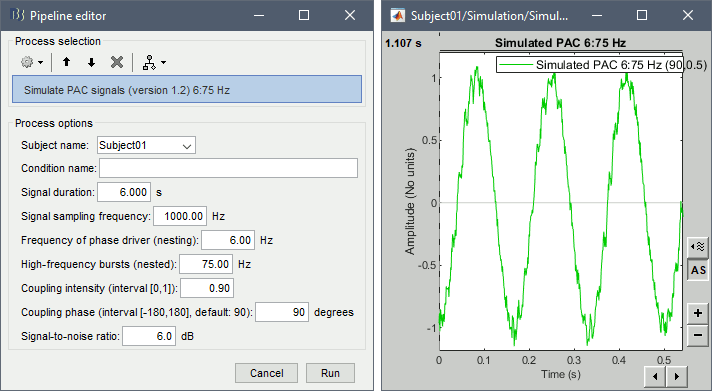|
Size: 985
Comment:
|
Size: 2519
Comment:
|
| Deletions are marked like this. | Additions are marked like this. |
| Line 4: | Line 4: |
| This tutorial addresses everything that can be called "simulation" in Brainstorm: simulation of simple signals, simulation of full source maps from a few scouts, simulation of MEG/EEG recordings from source maps (real or synthetic). Its goal is to group all the information that was spread across multiple tutorials and forum posts. | This tutorial addresses everything that can be called "simulation" in Brainstorm: simulation of simple signals, simulation of full source maps from a few scouts, simulation of MEG/EEG recordings from source maps (real or synthetic). Its goal is to group all the information that was previously spread across multiple tutorials and forum posts, and difficult to access. |
| Line 9: | Line 9: |
| You have no data in your database. Some process in the '''Simulate''' menu can generate signals and save them as new files in the database. Because you start from nothing, the Process1 list needs to be empty. Click on Run and try the following processes. === Simulate generic signals === This process allows to define a set of signals with Matlab code and save it in a Brainstorm file. Another example is available in the tutorial [[https://neuroimage.usc.edu/brainstorm/Tutorials/TimeFrequency#Simulation|Time-frequency]]. === Simulate PAC signals === This process generates synthesized data containing cross-frequency phase-amplitude coupling. It is fully documented in the tutorial [[https://neuroimage.usc.edu/brainstorm/Tutorials/TutPac#Simulate_signals|Phase-amplitude coupling: Method]]. {{attachment:simulate_pac.gif}} |
|
| Line 10: | Line 22: |
| == Simulate MEG/EEG recordings from sources == | == Simulate MEG/EEG recordings from real sources == == Simulate MEG/EEG recordings from simulated dipoles == These examples are based on the introduction tutorials, but can easily be transposed to any study. The inputs you need to provide to the process depend on the type of orientation constrains === Constrained === === Unconstrained === https://neuroimage.usc.edu/brainstorm/Tutorials/TutVolSource#Volume_scouts |
| Line 13: | Line 31: |
| A great simulation article was published by Prof. Debener's neuropsychology lab in Oldenburg. It uses Brainstorm to evaluate and improve the design of ear-EEG devices: | A great simulation article was published by Prof. Debener's neuropsychology lab in Oldenburg. It uses Brainstorm to evaluate and improve the design of ear-EEG devices. All the Matlab/Brainstorm scripts used in this study are available on [[https://figshare.com/articles/software/Matlab-code_for_simulation_of_dipole_sources/11907801|figshare]], together with some videos illustrating the simulations that were done. |
| Line 16: | Line 34: |
{{attachment:meiser.gif}} |
Simulations
Author: Francois Tadel
This tutorial addresses everything that can be called "simulation" in Brainstorm: simulation of simple signals, simulation of full source maps from a few scouts, simulation of MEG/EEG recordings from source maps (real or synthetic). Its goal is to group all the information that was previously spread across multiple tutorials and forum posts, and difficult to access.
Contents
Simulate signals
You have no data in your database. Some process in the Simulate menu can generate signals and save them as new files in the database. Because you start from nothing, the Process1 list needs to be empty. Click on Run and try the following processes.
Simulate generic signals
This process allows to define a set of signals with Matlab code and save it in a Brainstorm file. Another example is available in the tutorial Time-frequency.
Simulate PAC signals
This process generates synthesized data containing cross-frequency phase-amplitude coupling. It is fully documented in the tutorial Phase-amplitude coupling: Method.

Generate full source maps from scout signals
Simulate MEG/EEG recordings from real sources
Simulate MEG/EEG recordings from simulated dipoles
These examples are based on the introduction tutorials, but can easily be transposed to any study. The inputs you need to provide to the process depend on the type of orientation constrains
Constrained
Unconstrained
https://neuroimage.usc.edu/brainstorm/Tutorials/TutVolSource#Volume_scouts
Additional documentation
A great simulation article was published by Prof. Debener's neuropsychology lab in Oldenburg. It uses Brainstorm to evaluate and improve the design of ear-EEG devices. All the Matlab/Brainstorm scripts used in this study are available on figshare, together with some videos illustrating the simulations that were done.
Meiser A, Tadel F, Debener S, Bleichner MG
The Sensitivity of Ear-EEG: Evaluating the Source-Sensor Relationship Using Forward Modeling
Brain Topography, Aug 2020

